Anthropometric Measurements of Preschool Children in North Cameroon
Andreas Chiabi1, Danièle Nem2, Marie Kobela2, Lawrence Mbuagbaw3, Marie-Therese Obama4, Tetanye Ekoe212
3
4
Nearly 30% of the worlds population is currently suffering from one or more of the many forms of malnutrition. In Cameroon, 32% of under-five children suffer from moderate and chronic under nutrition, and 13% from the severe chronic form. This study aimed at evaluating the nutritional status of preschool children using anthropometric indices and the relationship of these to the mothers socioeconomic status in a regional setting in Cameroon. It was a cross sectional, descriptive and analytic study in which the anthropometric indicators of 375 preschool children were measured. Z scores of height for age, weight for height and weight for age were calculated using the WHO references. These Z scores were correlated with the mothers age, her level of education, her marital status and the size of household. Z scores < 2.0 for at least one of the following parameters viz; weight-to-age, weight-to-height and height-to-age were noted in 64 (17.1%) children. Similarly Z scores > 2.0 for at least one of the two parameters, weight-to-height and weight-to-age, were noted in 8 (2.1%) children. Hence, the overall prevalence of malnutrition among pre-school children was 19.2% and 8.5% were underweight, wasting was observed in 7.5% and obesity was observed in 0.5% of the children. Being underweight was significantly correlated with household size (P=0.036), and stunting was significantly associated with maternal age (P=0.02). Malnutrition is frequent in apparently healthy pre school children in northern Cameroon and significantly associated with the selected socio-economic parameters of the mothers. Hence, anthropometric measurements should be done during routine school health visits. This helps to diagnose growth faltering and timely referral to hospitals for appropriate management.
Keywords: Anthropometry - Preschool children - Garoua - Cameroon - Z-scoresManuscript Language: English














